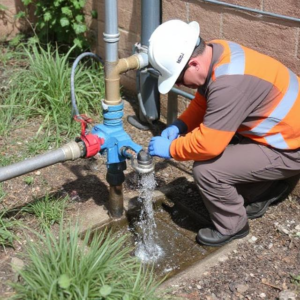Understanding: Why Some Homes Have It and Others Don’t
Water is an essential resource, and ensuring its safety is paramount for public health. One critical aspect of maintaining water quality is backflow testing. This process helps prevent contamination of the clean water supply by ensuring that backflow prevention devices are functioning correctly. But why do some homes have backflow testing while others don’t? Let’s dive into the details.
What is Backflow?
Backflow occurs when water flows in the opposite direction from its intended path, potentially contaminating the clean water supply. This reversal can happen due to a sudden change in water pressure, such as a burst pipe, firefighting activities, or routine maintenance work[2]. When backflow occurs, non-potable water from sources like irrigation systems, industrial processes, or even sewage can flow back into the clean water supply, posing significant health risks[1].
The Importance of Backflow Testing
Backflow testing is a proactive measure that ensures backflow prevention devices, such as check valves and backflow preventers, are functioning correctly. These devices are designed to allow water to flow in only one direction, preventing contamination[3]. Regular testing helps identify any issues with these devices, ensuring they operate as intended and comply with local regulations[4].
Why Some Homes Have Backflow Testing
Several factors determine whether a home requires backflow testing:
- Local Regulations: Municipalities and water authorities often have specific regulations regarding backflow prevention. In some areas, property owners are required to install backflow prevention devices and conduct regular testing to ensure compliance. These regulations are typically more stringent in areas with a higher risk of contamination, such as those with extensive irrigation systems or industrial activities.
- Type of Plumbing System: Homes with complex plumbing systems, such as those with irrigation systems, swimming pools, or fire sprinkler systems, are more likely to require backflow prevention devices and regular testing. These systems create additional cross-connections where backflow can occur, increasing the risk of contamination.
- Age of the Home: Older homes may not have been built with backflow prevention devices, as these requirements have become more common in recent years. As a result, newer homes are more likely to have these devices installed and undergo regular testing.
- Water Source: Homes that rely on private wells or other non-municipal water sources may have different requirements for backflow prevention. In some cases, these homes may not be subject to the same regulations as those connected to a municipal water supply.
The Backflow Testing Process
Backflow testing involves a series of pressure tests and visual inspections to ensure that backflow prevention devices are functioning correctly. Certified technicians typically perform these tests, following a checklist to ensure accuracy and thoroughness. The process includes:
- Inspection of Devices: Technicians visually inspect all backflow prevention devices installed in the plumbing system, checking for any signs of wear or damage.
- Pressure Tests: Technicians conduct pressure tests to ensure that the devices can maintain the correct pressure and prevent backflow. This may involve temporarily shutting off the water supply to test the devices under different pressure conditions.
- Compliance Check: Technicians verify that all devices are installed correctly and comply with applicable codes and standards.
Benefits of Backflow Testing
Regular backflow testing offers several benefits:
- Protecting Public Health: Ensuring that backflow prevention devices are functioning correctly helps protect the public from potential health hazards caused by contaminated water.
- Compliance with Regulations: Regular testing helps property owners comply with local regulations, avoiding potential fines and penalties.
- Preserving Water Quality: By preventing contamination, backflow testing helps maintain the quality of the water supply, reducing the need for costly water treatment processes.
- Preventing Damage: Backflow can cause damage to plumbing systems and other equipment. Regular testing helps identify and address issues before they cause significant damage.
Conclusion
Backflow testing is a crucial aspect of maintaining water quality and protecting public health. While not all homes require backflow testing, those with complex plumbing systems, newer construction, or specific local regulations are more likely to need it. By understanding the importance of backflow testing and ensuring that your home complies with local requirements, you can help safeguard your water supply and contribute to the overall health and safety of your community.
References
Frictionless Property Management

California Property Managers.
Connect with the premier property management team.
Looking for a full list of management services?
Looking for residential management?
Price is important, so here’s everything you need to know.
Fill out the form below and we will send you a price & proposal guide for our services.
Download the price guide and proposal.




